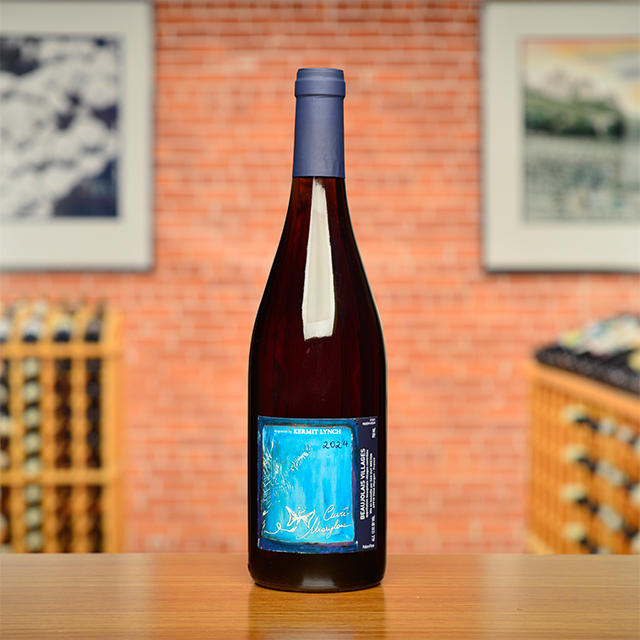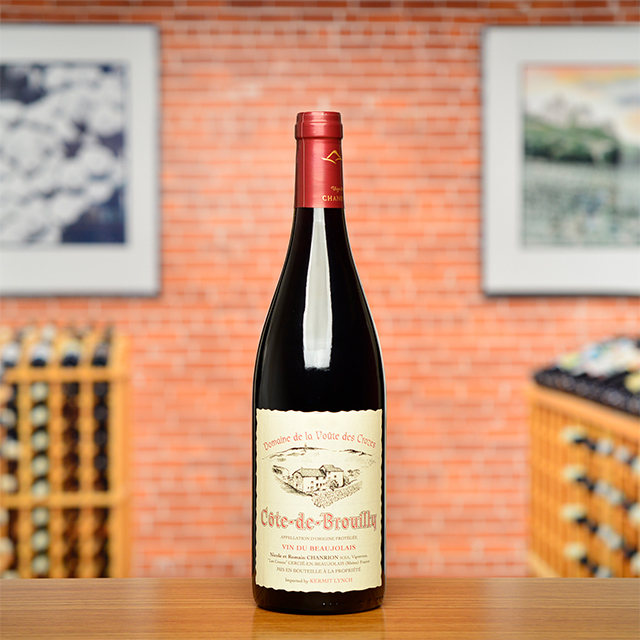Notify me
2023 Morgon
M. & C. Lapierre

Marcel Lapierre

Camille and Mathieu

The Lapierres’ courtyard
There’s a word I still struggle to translate from French, gourmandise, which refers to something one eats or drinks, not out of any kind of hunger or thirst, but rather for the pure pleasure of it all. Something that brings out an irresistible urge for self-indulgence of deliciousness. In other words, Lapierre’s Morgon! Perhaps that is the best translation after all. Pure gourmandise.
—Chris Santini
| Wine Type: | red |
| Vintage: | 2023 |
| Bottle Size: | 750mL |
| Blend: | Gamay |
| Appellation: | Morgon |
| Country: | France |
| Region: | Beaujolais |
| Producer: | M. & C. Lapierre |
| Winemaker: | Mathieu & Camille Lapierre |
| Vineyard: | 60 yrs, 10 ha |
| Soil: | Sandy decomposed granite |
| Aging: | Wines aged on fine lees in old Burgundy barrels |
| Farming: | Organic (certified) |
| Alcohol: | 13.5% |
More from this Producer or Region

2024 Beaujolais-Villages “Cuvée Marylou”
France | Beaujolais
Easy on the eyes (just look at that vibrant color!), easy on the head, easy enough on the wallet.

2024 Côte-de-Brouilly
France | Beaujolais
Loads of fun—juicy, round, structured, yet always elegant and focused. A classic favorite.

2021 Côte de Brouilly
France | Beaujolais
Alex Foillard fashions a Côte-de-Brouilly that strikes a deeper register, saturating the senses with tooth-staining fruit, gritty earth, and just a touch of the good funk.

2023 Côte de Brouilly
France | Beaujolais
Brambly and mineral, this bottling exudes both the convivial charm of Gamay and the crunchy intensity of the Côte de Brouilly.

2024 Beaujolais Blanc
France | Beaujolais
Do not miss this outstanding, value-driven Chardonnay from one of our most beloved French domaines.

2022 Régnié
France | Beaujolais
Savor it while you can, because your glass will be empty before you know it, leaving you only with the spicy, mineral-laden aftertaste of a bottle that went down way too easily.

2024 Côte de Brouilly
France | Beaujolais
Brambly and mineral, this bottling exudes both the convivial charm of Gamay and the crunchy intensity of the Côte de Brouilly.

2024 Beaujolais MAGNUM
France | Beaujolais
This Beaujolais offers the drinkability of the most effusive Morgons with the frankness of a chiseled Moulin-à-Vent.

2023 Chénas “Chassignol”
France | Beaujolais
A finessed, mineral-driven beauty from hundred-year-old vines at the highest point in Chénas.

2023 Chénas “Les Blémonts”
France | Beaujolais
Structured yet full of energy, with notes of blueberry, spice, and other things nice.
About The Producer
M. & C. Lapierre
Little would we know that when Marcel Lapierre took over the family domaine from his father in 1973, he was on the road to becoming a legend. Following the example of traditionalist Jules Chauvet, Marcel and three other local vignerons Jean Foillard, Jean-Paul Thévenet, and Guy Breton, soon hoisted the flag of Chauvet’s back-to-nature movement. Kermit dubbed this clan the Gang of Four, and the name has stuck ever since. The Gang called for a return to the old practices of viticulture and vinification. Sadly, the 2010 vintage was Marcel’s last. His children, Mathieu and Camille continue the great work that their father pioneered, introducing biodynamic vineyard practices and ensuring that Marcel's legacy lives on.
About The Region
Beaujolais

After years of the region’s reputation being co-opted by mass-produced Beaujolais Nouveau and the prevalence of industrial farming, the fortunes of vignerons from the Beaujolais have been on the rise in the past couple of decades. Much of this change is due to Jules Chauvet, a prominent Beaujolais producer who Kermit worked with in the 1980s and arguably the father of the natural wine movement, who advocated not using herbicides or pesticides in vineyards, not chaptalizing, fermenting with ambient yeasts, and vinifying without SO2. Chief among Chauvet’s followers was Marcel Lapierre and his three friends, Jean Foillard, Guy Breton, and Jean-Paul Thévenet—a group of Morgon producers who Kermit dubbed “the Gang of Four.” The espousal of Chauvet’s methods led to a dramatic change in quality of wines from Beaujolais and with that an increased interest and appreciation for the AOC crus, Villages, and regular Beaujolais bottlings.
The crus of Beaujolais are interpreted through the Gamay grape and each illuminate the variety of great terroirs available in the region. Distinguishing itself from the clay and limestone of Burgundy, Beaujolais soils are predominantly decomposed granite, with pockets of blue volcanic rock. The primary vinification method is carbonic maceration, where grapes are not crushed, but instead whole clusters are placed in a tank, thus allowing fermentation to take place inside each grape berry.
Much like the easy-going and friendly nature of many Beaujolais vignerons, the wines too have a lively and easy-drinking spirit. They are versatile at table but make particularly good matches with the local pork sausages and charcuterie. Though often considered a wine that must be drunk young, many of the top crus offer great aging potential.
More from Beaujolais or France
2024 Brouilly “Reverdon”
Château Thivin France | Beaujolais
2024 Beaujolais-Villages “Cuvée Marylou” MAGNUM
Guy Breton France | Beaujolais
2023 Chénas “Vibrations”
Domaine Thillardon France | Beaujolais
2024 Beaujolais
Domaine Dupeuble France | Beaujolais
2024 Morgon “Vieilles Vignes”
Jean-Paul et Charly Thévenet France | Beaujolais
2024 Côte de Brouilly MAGNUM
Château Thivin France | Beaujolais
2024 Beaujolais MAGNUM
Domaine Dupeuble France | Beaujolais
2024 Côte-de-Brouilly
Nicole Chanrion France | Beaujolais
2025 Beaujolais Nouveau
Domaine Dupeuble France | Beaujolais
2022 Côte de Brouilly
Guy Breton France | Beaujolais
2021 Côte de Brouilly
Alex Foillard France | Beaujolais
2023 Côte de Brouilly
Château Thivin France | Beaujolais
2024 Brouilly “Reverdon”
Château Thivin France | Beaujolais
2024 Beaujolais-Villages “Cuvée Marylou” MAGNUM
Guy Breton France | Beaujolais
2023 Chénas “Vibrations”
Domaine Thillardon France | Beaujolais
2024 Beaujolais
Domaine Dupeuble France | Beaujolais
2024 Morgon “Vieilles Vignes”
Jean-Paul et Charly Thévenet France | Beaujolais
2024 Côte de Brouilly MAGNUM
Château Thivin France | Beaujolais
2024 Beaujolais MAGNUM
Domaine Dupeuble France | Beaujolais
2024 Côte-de-Brouilly
Nicole Chanrion France | Beaujolais
2025 Beaujolais Nouveau
Domaine Dupeuble France | Beaujolais
2022 Côte de Brouilly
Guy Breton France | Beaujolais
2021 Côte de Brouilly
Alex Foillard France | Beaujolais
2023 Côte de Brouilly
Château Thivin France | Beaujolais
Kermit once said...

Kermit once said...
When buying red Burgundy, I think we should remember:
1. Big wines do not age better than light wine.
2. A so-called great vintage at the outset does not guarantee a great vintage for the duration.
3. A so-called off vintage at the outset does not mean the wines do not have a brilliant future ahead of them.
4. Red Burgundy should not taste like Guigal Côte-Rôtie, even if most wine writers wish it would.
5. Don’t follow leaders; watch yer parking meters.
Inspiring Thirst, page 174
















